Editor’s note: This article was originally published in January 2017. Updated April 2022.
Dogwood trees are a collection of tree species that belong to the dogwood genus ‘Cornus’. This Genus consists of approximately 30-60 mostly woody shrubs, some of which form small trees. The dogwood tree is an extremely common ornamental garden plant as it can offer beautiful flowers and often uniquely shaped fruits. As dogwood trees remain relatively small they are an ideal choice for landscape plantings where small trees are desired. Many dogwood species are native to the U.S. and some are not, such as the very popular Kousa Dogwood which is native to Asia.
All dogwoods produce berries, but not all of these berries are edible. Dogwood fruit comes in many shapes, sizes, and colors. This article will discuss the 3 most common dogwood tree species and how to identify them. We’ll compare flowers and fruits, and also discuss whether the fruits of that species are edible.
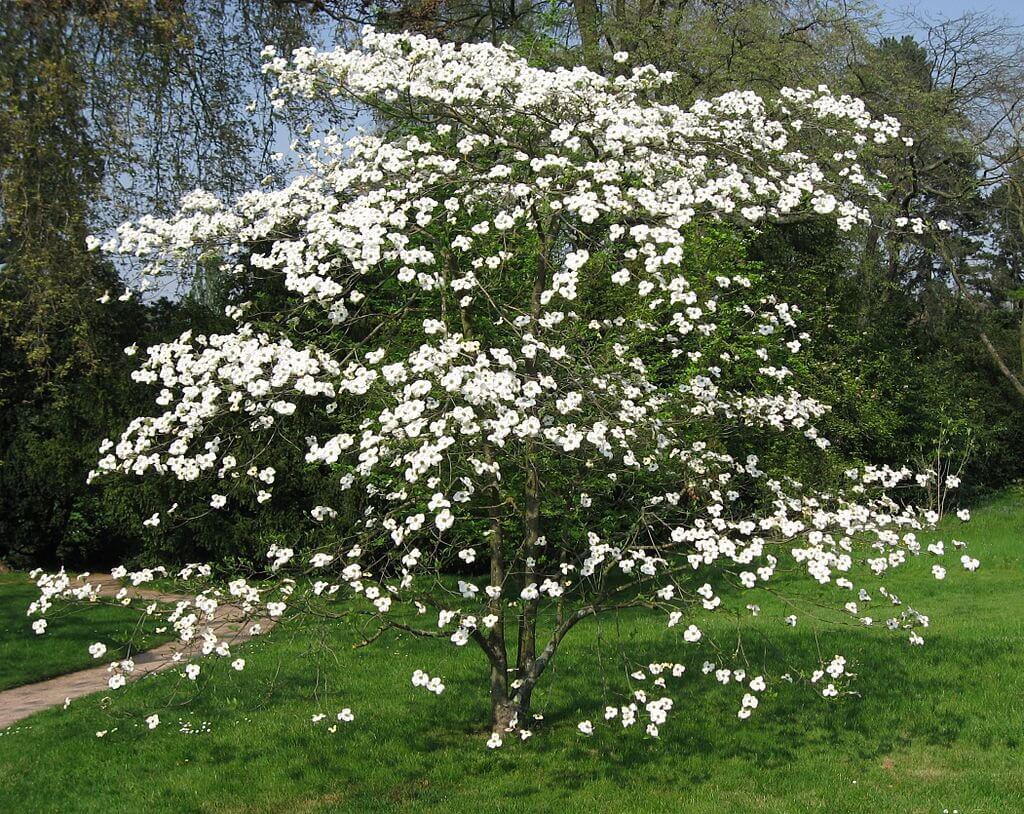
Flowering Dogwood: Fruits Not Edible
Flowering Dogwood (Cornus florida) is one of the two most common ornamental species of dogwood, the other being Kousa dogwood. Flowering dogwood is native to the eastern United States, where it can be found in woodlands as well as landscapes. Flowering dogwoods prefer part shade and are perfectly adjusted to the acidic soil of the northeast. You can find flowering dogwood saplings online if you’d like to introduce them to your garden. While it is a beautiful species, the berries are not edible, so flowering dogwood can be admired for its beauty only.
The red berries grow in clusters and mature into the fall. Some reports describe them as poisonous, but in general, the berries are simply considered very astringent and bitter. So these dogwood berries are not considered edible.
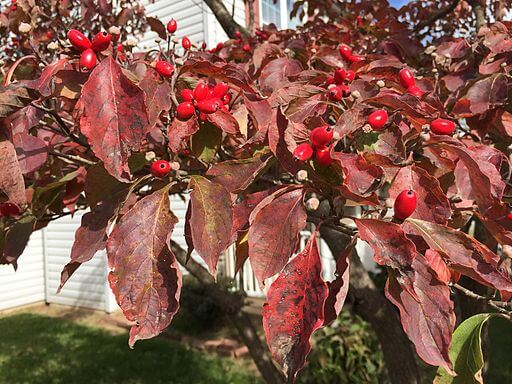
How to identify Flowering dogwood
All Dogwood trees have similarly shaped leaves. They’re usually a simple, ovate shape with visible veining. As an ovate leaf shape is one of the most common leaf shapes in the botanical world, dogwood leaves are not easily identified by their leaves. Flowering Dogwood is best identified by its fruit clusters. These are bright red berries with an elongated shape that are not considered edible.
Flowering White Dogwood and Pink Dogwood
Flowering Dogwood (Cornus florida) has very showy flowers in early spring. The species usually has white flowers, however as the species is widely cultivated, many different varieties have been developed.
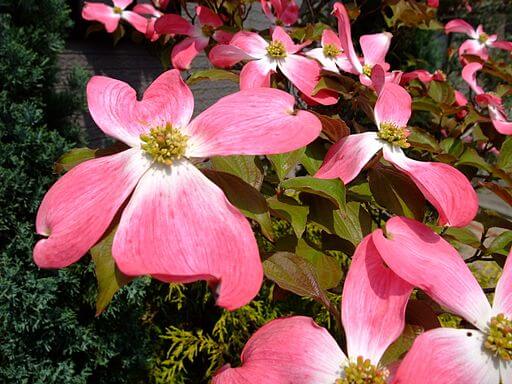
Dogwood flower – Or is it?
Technically the showy part of the dogwood flower is not a flower petal but a modified leaf called a bract. The flowers of Cornus florida are usually white but pink-flowered varieties have been developed. Both pink and white flowering dogwood are very common in landscaped parks and gardens.
Kousa Dogwood: Edible Fruit
Kousa dogwood (Cornus kousa) is another very popular ornamental dogwood species. It’s native to Asia and naturalized in New York state, but there are also a number of cultivated varieties with slightly different flower and fruit characteristics. Kousa dogwoods are usually chosen for their small size and relatively good pest resistance. They flower in the spring and fruit in late summer and early fall. You can buy Kousa dogwood saplings online if you want to grow a tree yourself.
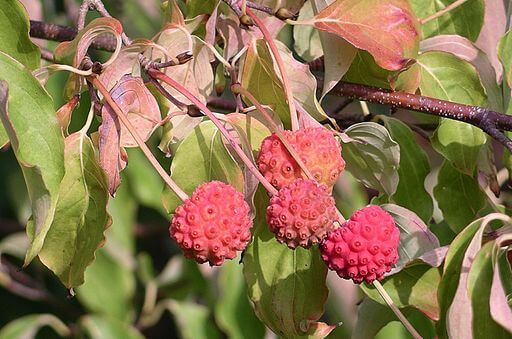
The fruits of the Kousa dogwood species are edible and one of the tastiest and most prolific wild edibles that can be found in the landscape. Although not truly a “wild” edible because Kousa dogwood does not naturalize frequently in most areas. Part of the trick to harvesting Kousa dogwood berries is choosing berries at the right stage. Check out our Kousa dogwood guide that provides more information on how to know when Kousa dogwood berries are ready to eat.
How to identify Kousa dogwood
Kousa Dogwood can be identified by two prominent characteristics — the bark and the fruits. As Kousa dogwood gets older the lower bark peels away to create a unique pattern similar to sycamore tree bark. Another distinguishing factor is the unusual shape of Kousa dogwood berries. They’re approx. 1″ diameter in height and width, with bright red coloring. However, the outer skin on the berry somewhat resembles lychee fruit, with a bumpy, protuberant texture. The berries are technically an aggregate fruit (like raspberries and blackberries) but they look like a single large berry.
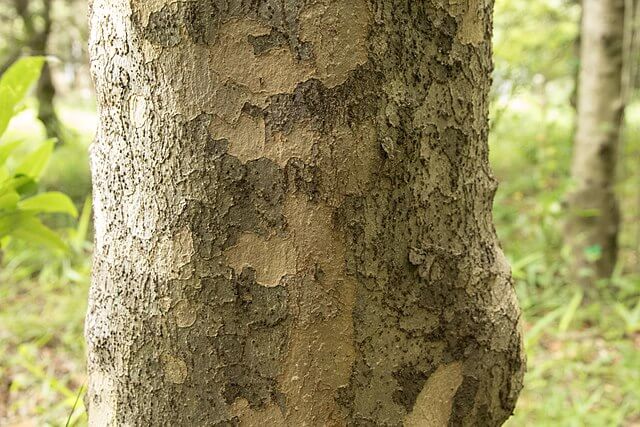
Cornelian Cherry Dogwood: Edible Fruit
Cornelian cherry dogwood (Cornus mas) is another dogwood tree that is commonly sold as a landscape tree. This tree is not used nearly as often as the other species mentioned above, but it still has some interesting potential in the landscape. This tree is native to Eurasia but grows very well in the eastern U.S. One of the most fascinating features of this plant is its early flowering period. This plant flowers very early, sometimes before forsythia, it also has small yellow flowers, not unlike forsythia. This is one of my favorite trees, you can buy saplings on amazon to grow them on your own property.

The fruits of the Cornelian cherry dogwood are edible. In summer you’ll see clusters of single dark red smooth berries that resemble coffee berries. There is one large seed in the middle of each berry, but you can still get a significant amount of flesh from each fruit. They have a good taste but are very sour. I happen to love sour fruits so they are one of my favorites. Cornelian cherry dogwood trees often produce an abundance of fruit, so it is possible to use them in pies and jams.
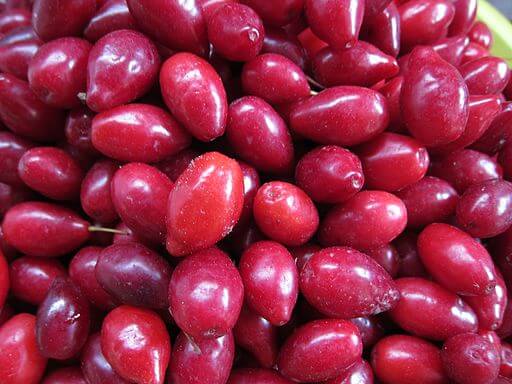
Even though the leaves and bark are very similar, distinguishing this tree from flowering dogwood is easy. The Cornelian cherry dogwood tree has a completely different flower and fruit schedule than the flowering dogwood. Cornelian cherry dogwood flowers and fruits much earlier. So at any point throughout the year, except for winter, you should be able to see flowers or fruits or expect to see them depending on which tree you’re looking at. Since the berries and leaves on this tree are not distinctive enough compared to other plants in the landscape it’s recommended that if you believe you are looking at a cornelian cherry dogwood then you should compare that plant directly to an identification guide.

Conclusion
As beautiful, ornamental trees, dogwood species can be a common find in parks and public gardens. It is important to take care when foraging for edible dogwood fruits. In these landscaped areas plants may have been exposed to herbicides or pesticides. So make sure to always follow safe foraging guidelines when collecting wild fruits and plants.
Have you ever tried the edible fruits of Kousa dogwood or the Cornelian cherry dogwood?
Featured Image: Kousa dogwood fruits by Amada44 on Wikimedia Commons
Many of our readers find that subscribing to Eat The Planet is the best way to make sure they don't miss any of our valuable information about wild edibles.
See our privacy policy for more information about ads on this site

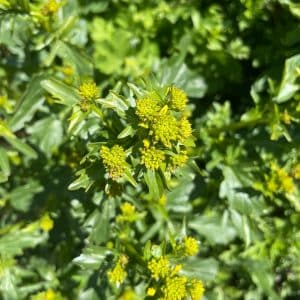
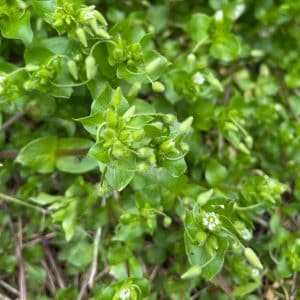
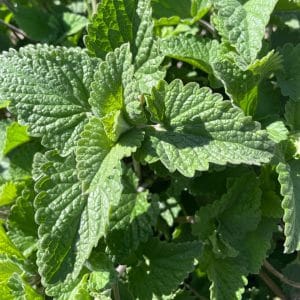


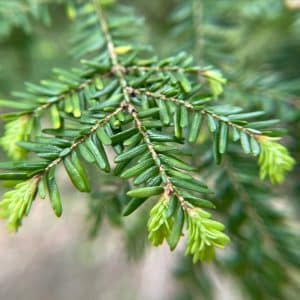
5 Responses
I read in _How to Live on Nothing_, by Joan Ranson Shortney, regarding a recipe for Dandelion Wine (p. 34), “You can follow this same recipe with other flowers, particularly dogwood blossoms, which are said to make one of the best wines.” Has anyone ever tried making dogwood blossom wine? And are ALL dogwood blossoms appropriate for this?
Dogwood blossom wine is one I have not heard of before, I would imagine it is not all dogwood blossoms. Dogwood species seem to be pretty different in terms of edibility and fruit characteristics. That leads me to believe that there is no reason why the blossoms would be any different. I wonder which species is being referenced there.
Hi I’m wondering if gray dogwood (Cornus racemosa) is edible, non poisonous, or toxic?
I cannot find my native dogwoods here in Arkansas. I havent found any website with them, yet. Wish me luck! And please, I BEG, have a good day! (or night!)
You might like to know the red robins (birds) came this week to Elwood on Long Island to eat the Cornelian cherry berries.